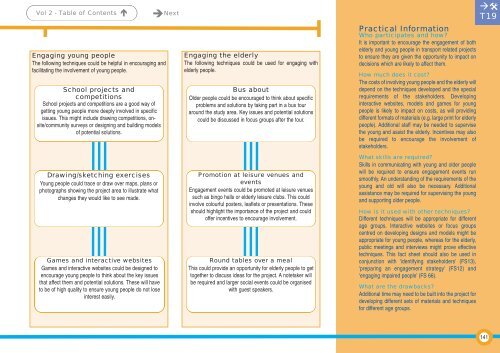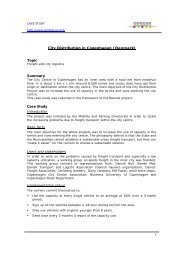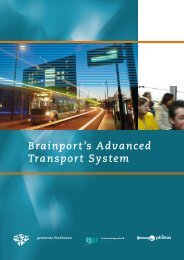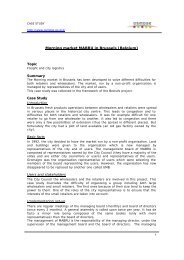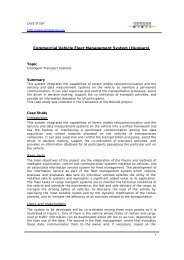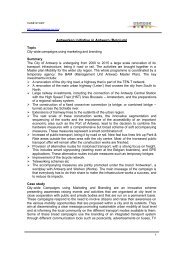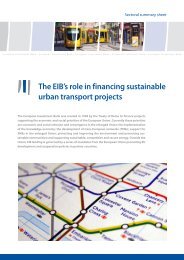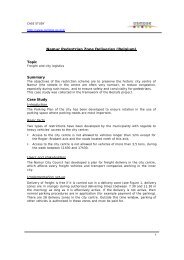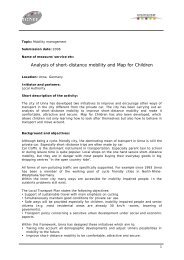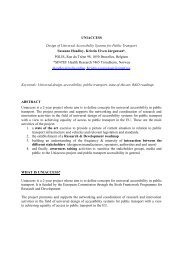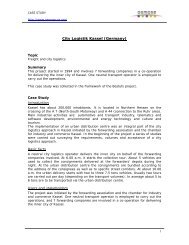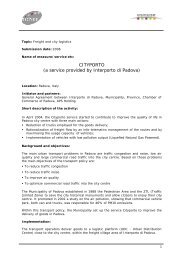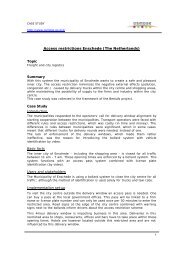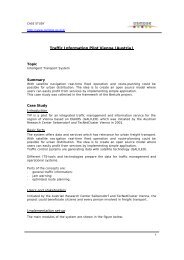Successful transport decision-making - Osmose
Successful transport decision-making - Osmose
Successful transport decision-making - Osmose
You also want an ePaper? Increase the reach of your titles
YUMPU automatically turns print PDFs into web optimized ePapers that Google loves.
Vol 2 - Table of Contents Next Practical Information<br />
Who participates and how?<br />
It is important to encourage the engagement of both<br />
Engaging young people<br />
The following techniques could be helpful in encouraging and<br />
facilitating the involvement of young people.<br />
School projects and<br />
competitions<br />
School projects and competitions are a good way of<br />
getting young people more deeply involved in specific<br />
issues. This might include drawing competitions, onsite/community<br />
surveys or designing and building models<br />
of potential solutions.<br />
Engaging the elderly<br />
The following techniques could be used for engaging with<br />
elderly people.<br />
Bus about<br />
Older people could be encouraged to think about specific<br />
problems and solutions by taking part in a bus tour<br />
around the study area. Key issues and potential solutions<br />
could be discussed in focus groups after the tour.<br />
elderly and young people in <strong>transport</strong> related projects<br />
to ensure they are given the opportunity to impact on<br />
<strong>decision</strong>s which are likely to affect them.<br />
How much does it cost?<br />
The costs of involving young people and the elderly will<br />
depend on the techniques developed and the special<br />
requirements of the stakeholders. Developing<br />
interactive websites, models and games for young<br />
people is likely to impact on costs, as will providing<br />
different formats of materials (e.g. large print for elderly<br />
people). Additional staff may be needed to supervise<br />
the young and assist the elderly. Incentives may also<br />
be required to encourage the involvement of<br />
stakeholders.<br />
<br />
T19<br />
Drawing/sketching exercises<br />
Young people could trace or draw over maps, plans or<br />
photographs showing the project area to illustrate what<br />
changes they would like to see made.<br />
Games and interactive websites<br />
Games and interactive websites could be designed to<br />
encourage young people to think about the key issues<br />
that affect them and potential solutions. These will have<br />
to be of high quality to ensure young people do not lose<br />
interest easily.<br />
Promotion at leisure venues and<br />
events<br />
Engagement events could be promoted at leisure venues<br />
such as bingo halls or elderly leisure clubs. This could<br />
involve colourful posters, leaflets or presentations. These<br />
should highlight the importance of the project and could<br />
offer incentives to encourage involvement.<br />
Round tables over a meal<br />
This could provide an opportunity for elderly people to get<br />
together to discuss ideas for the project. A notetaker will<br />
be required and larger social events could be organised<br />
with guest speakers.<br />
What skills are required?<br />
Skills in communicating with young and older people<br />
will be required to ensure engagement events run<br />
smoothly. An understanding of the requirements of the<br />
young and old will also be necessary. Additional<br />
assistance may be required for supervising the young<br />
and supporting older people.<br />
How is it used with other techniques?<br />
Different techniques will be appropriate for different<br />
age groups. Interactive websites or focus groups<br />
centred on developing designs and models might be<br />
appropriate for young people, whereas for the elderly,<br />
public meetings and interviews might prove effective<br />
techniques. This fact sheet should also be used in<br />
conjunction with 'identifying stakeholders' (FS13),<br />
'preparing an engagement strategy' (FS12) and<br />
‘engaging impaired people’ (FS 66).<br />
What are the drawbacks?<br />
Additional time may need to be built into the project for<br />
developing different sets of materials and techniques<br />
for different age groups.<br />
141


